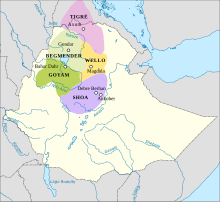Tigray (province)
Tigray ( ትግራይ təgray [ tɨɡraj ], also Tigré ) was a province in the Abyssinian Empire , from 1974 a province of Ethiopia under the Derg regime. In the People's Democratic Republic of Ethiopia from 1987 it was autonomous and since 1995 through the adoption of the new constitution it has been an independent region - the Tigray region , and not a province - within the Federal Democratic Republic of Ethiopia. The capital was Mek'ele .
At the time of its dissolution, several historical provinces, including Semien , Agame , Tembien and Enderta , were united with it to form the Tigray region. The region around the Tigrinya-speaking areas of Tsellemti and Wolqayt (Wolkait) to the south and west did not belong to the Tigray Province until then; it was claimed by the separatist People's Liberation Front of Tigray and previously belonged to the Wollo and Begemder (Gondar) provinces .
history
Habesha , then Proto- Tigray (people) and Proto- Amharen , were the people who supported the state in the Aksumite Empire in the first millennium BC. The heart of the Aksumite Empire was in the later province of Tigray. The official language of the empire, Old Ethiopian , later remained the church language of the Ethiopian Orthodox and Eritrean Orthodox Tewahedo Church . The capital Aksum was in the center of Tigray.
During the Middle Ages, the position of Tigray Mekonnen ( governor of Tigray ) was established to rule over the area. Other districts included Akkele Guzay (now part of Eritrea ) and the Kingdom of the Bahr Negus . The Bahr Negus ruled over most of the later province of Eritrea and the Shire district (including the capital Shire ) in West Tigray. At the time when the Tigray Mekonnen ruled next to the Bahr Negus, the border between the two kingdoms was the Mareb River , which today forms the border between the state of Eritrea and the Tigray region.
In the 17th century, the later main province of Tigray was surrounded by 13 provinces: Tembien, Shire, Serae, Hamasien , Bur, Sam'a, Agame, Amba Senayt, Gar'alta, Enderta, Sahart and Abergele .
After the Bahr Negus lost power following the Bahr Negus Yeshaq rebellions , the title of Tigray Mekonnen gained more and more power compared to the Bahr Negus. The Tigray Mekonnen ruled over parts of what is now Eritrea, especially in the 19th century.
During the politically uncertain era of the princes , the Zemene Mesafint period, the power of both rulers waned to no more than meaningless titles, and the sovereign, who in return dominated the region, received the titles Ras and Dejazmach from the Ethiopian emperor and used them thenceforth. The first ruler under this title was Ras Mikael Sehul . Tigray rulers, including Wolde Selassie , took turns with Ras' from other provinces, mainly from Begemder and Yejju . In reality, during Zemene Mesafint, warlords ruled instead of Ethiopian monarchs.
In the middle of the 19th century several rulers of Tigray strove for the Ethiopian imperial crown, but both Dejazmach Wube Haile Mariam and his nephew and successor Dejazmach "Agaw" Neguse (Negussie) Woldemikael were defeated by Tewodros II in 1855 and 1861 respectively . In the mid-1880s, the rulers of Tembien and Enderta succeeded in gaining control of their dynasty over Tigray. One of its members, Dejazmach Kassai Mercha , even rose to the imperial throne in 1872 under the name of Yohannes IV . Following his death during the Battle of Metemma , the Ethiopian throne came under the control of the King of Shewa , and the rebellion of Yohannes' successor Ras Mengesha in Tigray was put down in 1899. The power center of the Abyssinian Empire was thus moved south from Tigray.
In the 1970s, when the Abyssinian Empire was abolished and a socialist military dictatorship was formed in its place, militant movements formed here who wanted to achieve the independence of the province and fought in a civil war against the Ethiopian central government. Among them were the nationalist Tigray Liberation Front and the Communist People's Liberation Front of Tigray , the latter being the only political force that prevailed in the end.
The province of Tigray in its current form was finally abolished in 1995 as part of the new administrative structure of Ethiopia after the Revolutionary Democratic Front of the Ethiopian Peoples came to power - which was led by the People's Liberation Front of Tigray . Until 1995 it was called Region 1 . The eastern part of the former Tigray province (which had been separated as part of the Assab Autonomous Region in 1987 ), which belongs to the Afar Plain , became part of the Afar region .
swell
- ↑ Wolbert GC Smidt, in: Abdulkader Saleh, Nicole Hirt, Wolbert GC Smidt, Rainer Tetzlaff (eds.): Peace areas in Eritrea and Tigray under pressure: Identity construction, social cohesion and political stability , LIT Verlag, Münster 2008, ISBN 978-3 -8258-1858-6 (p. 230)
- ↑ on the territorial claims of the TPLF cf. Alex de Waal, Africa Watch: Evil Days. 30 Years of War and Famine in Ethiopia , 1991 (p. V, 33)
- ^ Richard Pankhurst , History of Ethiopian Towns (Wiesbaden; Franz Steiner Verlag, 1982), 1st edition, page 201.
- ^ Richard Pankhurst, An Introduction to the Economic History of Ethiopia (London: Lalibela House, 1962), 328
- ^ Gebru Tareke: Ethiopia: Power and Protest. Peasant Revolts in the Twentieth Century , Red Sea Press 1996, ISBN 978-1-56902-019-7 , pp. 90f.

